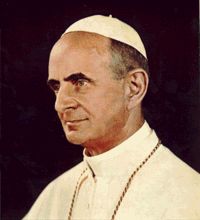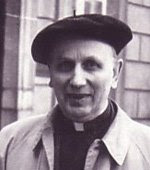Pope John was elected on 28 October 1958. He called the Second Vatican Council (1962–1965) but did not live to see it to completion. He died in 1963, only four-and-a-half years after his election.
Background information - click on blue book titles below:

Paul VI decided to continue Vatican II (canon law dictates that a council is suspended at the death of a pope), and brought it to completion in 1965. Faced with conflicting interpretations and controversies, he directed the implementation of its reform goals, which included the largest revision to the Church's Liturgy ever—and the first major revision since the Council of Trent, held 400 years prior to Vatican II—until his death in 1978.
Father Francis X. Murphy (1915–2002) was a Redoemptorist chaplain and theology professor. He is most known for his articles about the Second Vatican Council published under the pseudonym Xavier Rynne
 Letters from Vatican City by Xavier Rynne (pseud.)
Letters from Vatican City by Xavier Rynne (pseud.)
 Vatican Council II / Xavier Rynne.
Vatican Council II / Xavier Rynne.
 Council daybook, Vatican II, session 1-4. Edited by Floyd Anderson, director.
Council daybook, Vatican II, session 1-4. Edited by Floyd Anderson, director.
 Le Concile au Jour le Jour. By Yves Congar
Le Concile au Jour le Jour. By Yves Congar
 Documenti ufficiali del Concilio Vaticano II : Testo ufficiale e traduzione italiana, Decima edizione (reveduta e aggiomata).
Documenti ufficiali del Concilio Vaticano II : Testo ufficiale e traduzione italiana, Decima edizione (reveduta e aggiomata).
 Vatican Diary: A Protestant Observes . . . Vatican Council II. By Douglas Horton
Vatican Diary: A Protestant Observes . . . Vatican Council II. By Douglas Horton
 Vatican II by Antoine Wenger. Translated by Robert J. Olsen.
Vatican II by Antoine Wenger. Translated by Robert J. Olsen.
 Decrees of the ecumenical councils / edited by Norman P. Tanner.
Decrees of the ecumenical councils / edited by Norman P. Tanner.
The Dogmatic Constitution Lumen Gentium of the Second Vatican Ecumenical Council, which was also a document on the Church itself, explicitly reaffirmed the definition of papal infallibility, so as to avoid any doubts, expressing this in the following words:
| "This Sacred Council, following closely in the footsteps of the First Vatican Council, with that Council teaches and declares that Jesus Christ, the eternal Shepherd, established His holy Church, having sent forth the apostles as He Himself had been sent by the Father;(136) and He willed that their successors, namely the bishops, should be shepherds in His Church even to the consummation of the world. And in order that the episcopate itself might be one and undivided, He placed Blessed Peter over the other apostles, and instituted in him a permanent and visible source and foundation of unity of faith and communion. And all this teaching about the institution, the perpetuity, the meaning and reason for the sacred primacy of the Roman Pontiff and of his infallible magisterium, this Sacred Council again proposes to be firmly believed by all the faithful." |
The Catechism of the Catholic Church spells out the infallibility of an ecumenical council:
"The Roman Pontiff, head of the college of bishops, enjoys this infallibility in virtue of his office, when, as supreme pastor and teacher of the faithful - who confirms his brethren in the Faith - he proclaims by a definitive act a doctrine pertaining to Faith or morals.... The infallibility promised to the Church is also present in the body of bishops when, together with Peter's successor, they exercise the supreme Magisterium," above all in an ecumenical council. (Item 891)
Consequently, the teachings of the Second Vatican Council are the official teachings of the Church.
Revelation - Trent and Vatican Council I
The Second Vatican Council: "The beginning of a beginning...." Karl Rahner
 Theological highlights of Vatican II / Joseph Ratzinger, now Pope Benedict XVI ; with an introduction by Thomas P. Rausch.
Theological highlights of Vatican II / Joseph Ratzinger, now Pope Benedict XVI ; with an introduction by Thomas P. Rausch.
 The road to Vatican II : key changes in theology / Maureen Sullivan.
The road to Vatican II : key changes in theology / Maureen Sullivan.
 What happened at Vatican II / John W. O'Malley.
What happened at Vatican II / John W. O'Malley.
 Vatican II : assessment and perspectives : twenty-five years after (1962-1987) / edited by Rene Latourelle.
Vatican II : assessment and perspectives : twenty-five years after (1962-1987) / edited by Rene Latourelle.
 True and false reform in the church / Yves Congar
True and false reform in the church / Yves Congar
 Vatican Council II / Xavier Rynne.
Vatican Council II / Xavier Rynne.
 Guests in their own house : the women of Vatican II / Carmel Elizabeth McEnroy
Guests in their own house : the women of Vatican II / Carmel Elizabeth McEnroy
 History of Vatican II / edited by Giuseppe Alberigo
History of Vatican II / edited by Giuseppe Alberigo
 Doing theology / Jared Wicks.
Doing theology / Jared Wicks.
 Letters from Vatican City by Xavier Rynne (pseud.)
Letters from Vatican City by Xavier Rynne (pseud.)
 Romano Guardini: A Precursor to Vatican II / Robert A. Krieg.
Romano Guardini: A Precursor to Vatican II / Robert A. Krieg.
 Reliving Vatican II : it's all about Jesus Christ / Justin Rigali.
Reliving Vatican II : it's all about Jesus Christ / Justin Rigali.
 Modern Christian thought / James C. Livingston.
Modern Christian thought / James C. Livingston.
 A brief history of Vatican II / Giuseppe Alberigo ; translated by Matthew Sherry.
A brief history of Vatican II / Giuseppe Alberigo ; translated by Matthew Sherry.
 Paul VI : the first modern Pope / Peter Hebblethwaite.
Paul VI : the first modern Pope / Peter Hebblethwaite.
 Meet Henri De Lubac / Rudolf Voderholzer
Meet Henri De Lubac / Rudolf Voderholzer
 My struggle for freedom : memoirs / Hans Küng
My struggle for freedom : memoirs / Hans Küng